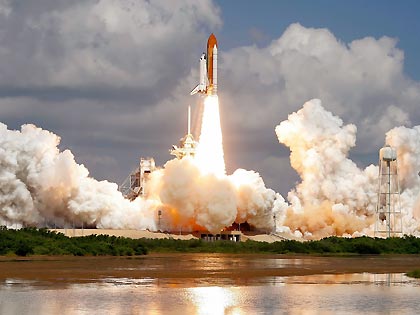|
NASA worries object falling from Discovery
(chinadaily.com.cn)
Updated: 2005-07-27 11:54
Now that the Discovery is in orbit, intense examination begins. One camera on
the shuttle caught a mysterious object falling from the shuttle at liftoff;
radar detected another, about two minutes into the flight on Tuesday.
The New York Times reported that Discovery’s 12-day mission will be the most
photographed in the history of the shuttle program, with all eyes on the
spacecraft to see if it suffered that kind of damage from blastoff debris that
brought down the Columbia in February 2003.

The space shuttle
Discovery lifts off from pad 39B at the Kennedy Space Center in Cape
Canaveral, Florida, July 26, 2005. [Reuters] |
The intense examinations may be a mixed blessing. The more NASA looks for
damage, experts say, the more it will find. And the risks of overreaction to
signs of damage while the shuttle is in orbit may be just as great as the risks
of playing them down, the Times commented.
"How do you distinguish - discriminate - between damage which is critical and
damage which is inconsequential?" asked David Wolf, an astronaut who spent four
months aboard the Russian space station Mir. "We could be faced with very
difficult decisions, in part because of all this additional information."
The shuttle program has lived with damage from debris from the very first
flight, in 1981; in 113 missions the orbiters have been hit by debris some
15,000 times, mostly on liftoff. The National Aeronautics and Space
Administration (NASA) replaces about 100 insulating tiles after every flight and
repairs many more than that.
Thanks to a $15 million laser camera system developed by a Canadian company,
Neptec, for example, NASA can detect a crack of just two-hundredths of an inch.
On the leading edge of the orbiter's wing, such a crack could admit dangerous
amounts of superheated gas during re-entry to the earth atmosphere, the New York
Times reported.
|
 | | | American women call for end of war | | |  | | | Israeli forces storm Gaza settlement | | |  | | | South Korean, DPRK separated families hold video reunions | | |
|
| |
 |
|
 |
|
|
Today's
Top News |
|
|
|
Top World
News |
 |
|
 |
|
|
|
|
|
|